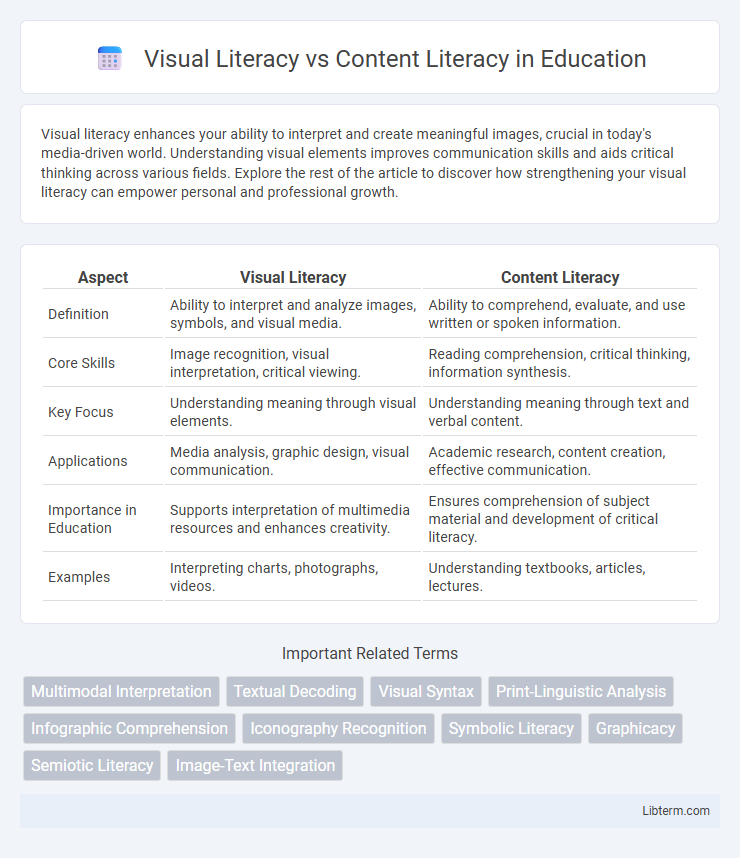Visual literacy enhances your ability to interpret and create meaningful images, crucial in today's media-driven world. Understanding visual elements improves communication skills and aids critical thinking across various fields. Explore the rest of the article to discover how strengthening your visual literacy can empower personal and professional growth.
Table of Comparison
| Aspect | Visual Literacy | Content Literacy |
|---|---|---|
| Definition | Ability to interpret and analyze images, symbols, and visual media. | Ability to comprehend, evaluate, and use written or spoken information. |
| Core Skills | Image recognition, visual interpretation, critical viewing. | Reading comprehension, critical thinking, information synthesis. |
| Key Focus | Understanding meaning through visual elements. | Understanding meaning through text and verbal content. |
| Applications | Media analysis, graphic design, visual communication. | Academic research, content creation, effective communication. |
| Importance in Education | Supports interpretation of multimedia resources and enhances creativity. | Ensures comprehension of subject material and development of critical literacy. |
| Examples | Interpreting charts, photographs, videos. | Understanding textbooks, articles, lectures. |
Understanding Visual Literacy: Definition and Importance
Visual literacy refers to the ability to interpret, analyze, and create meaning from visual images and symbols, essential in today's image-driven communication landscape. Understanding visual literacy enables individuals to critically evaluate visual media, enhancing comprehension beyond text-based information. Mastery of visual literacy is key for success in education, digital media, and professional environments where visual content is pervasive.
Defining Content Literacy: Scope and Relevance
Content literacy encompasses the ability to understand, analyze, and evaluate information across various subject areas, emphasizing critical thinking and comprehension skills. It involves interpreting text, data, and other media relevant to specific disciplines such as science, history, and literature. Mastery of content literacy enables learners to navigate complex texts, synthesize knowledge, and apply it effectively within academic and real-world contexts.
Key Differences Between Visual and Content Literacy
Visual literacy emphasizes interpreting and understanding images, symbols, and visual media, while content literacy focuses on comprehending and analyzing written texts and spoken language. Key differences include the modes of communication: visual literacy decodes visual elements like color, composition, and imagery, whereas content literacy relies on vocabulary, syntax, and textual structure. Mastery in visual literacy enhances the ability to derive meaning from visual content, contrasting with content literacy's goal of extracting information and intent from textual sources.
Skills Required for Visual vs Content Literacy
Visual literacy requires skills such as interpreting images, understanding visual symbolism, and analyzing spatial relationships to derive meaning effectively. Content literacy emphasizes critical reading, comprehension of textual information, and the ability to evaluate and synthesize written data. Both literacies demand critical thinking, but visual literacy focuses on non-verbal cues while content literacy centers on language and verbal content processing.
The Role of Visual Literacy in Modern Education
Visual literacy enables students to interpret, analyze, and create meaning from images, graphs, and videos, which are increasingly integral to digital communication. Its role in modern education is critical for fostering critical thinking skills and enhancing comprehension across diverse subjects through multimodal learning. Integrating visual literacy alongside content literacy prepares learners for a media-rich environment, improving their ability to decode and synthesize complex information.
Content Literacy: Building Strong Comprehension Skills
Content literacy involves understanding and analyzing subject-specific texts, enabling readers to grasp complex concepts and ideas within disciplines such as science, history, and literature. Developing strong comprehension skills in content literacy requires familiarity with specialized vocabulary, text structures, and critical thinking strategies to interpret, evaluate, and synthesize information effectively. Mastery of content literacy enhances academic success by empowering learners to engage deeply with materials, make informed connections, and communicate knowledge accurately across various fields.
Integrating Visual and Content Literacies in the Classroom
Integrating visual and content literacies in the classroom enhances students' critical thinking and comprehension by enabling them to analyze and interpret both textual and visual information effectively. Effective strategies include using multimodal resources such as infographics, videos, and diagrams alongside traditional texts to foster deeper understanding and engagement. Teachers can scaffold learning by guiding students to decode visual elements and connect them to content knowledge, promoting a holistic learning experience that aligns with Common Core and 21st-century literacy standards.
Challenges in Teaching Visual and Content Literacy
Teaching visual literacy often challenges educators due to the need to develop students' abilities to interpret, analyze, and critically evaluate diverse visual media formats such as infographics, videos, and advertisements. Content literacy instruction requires addressing complex comprehension strategies for varied texts, including informational, technical, and digital content, while overcoming obstacles like limited background knowledge and vocabulary gaps. Both literacies demand integrated pedagogical approaches that balance cognitive skills with media-specific analytical techniques to prepare students for multimodal communication in the digital age.
Assessing Visual Literacy vs Content Literacy Skills
Assessing visual literacy skills involves evaluating an individual's ability to interpret, analyze, and create meaning from images, symbols, and visual media, emphasizing perception and critical thinking. Content literacy assessment measures understanding and mastery of subject-specific knowledge through reading, writing, and comprehension of textual information. Effective evaluation of both skills requires targeted tools that address the distinct cognitive processes involved in visual interpretation versus textual analysis.
Future Trends: Evolving Literacies in a Digital Age
Visual literacy and content literacy are rapidly evolving in response to the digital age's demands, with future trends emphasizing the integration of multimedia analysis and critical thinking. Emerging technologies such as augmented reality (AR) and artificial intelligence (AI) are reshaping how individuals interpret visual data and textual information, requiring enhanced skills in deciphering complex, multimodal content. Educational frameworks increasingly prioritize these literacies to prepare learners for a landscape where digital fluency and interpretative agility are essential for effective communication and information evaluation.
Visual Literacy Infographic

 libterm.com
libterm.com